

In our gardens, every living creature has a place. It’s all a question of balance! Precious services are rendered even by every single snail in our lots, even though their population must be controlled. Let’s take a closer look at this surprising little gastropod…
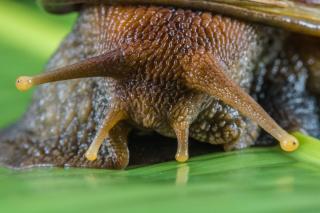 It is a land mollusk, part of the Gastropod family.
It is a land mollusk, part of the Gastropod family. In winter, it hibernates, finding a nice hidden spot under a shingle, a slab of wood or around the compost pile. Some species gather together on a branch or twig. Such a group of snails is called a “rout” or a “walk” of snails, even though they stay put!
In winter, it hibernates, finding a nice hidden spot under a shingle, a slab of wood or around the compost pile. Some species gather together on a branch or twig. Such a group of snails is called a “rout” or a “walk” of snails, even though they stay put!The shell, similar to limestone, comes in many different shapes and colors. It protects the snail from predators, and also insulates it from extreme cold or heat. When danger lurks, the snail retreats inside its shell and starts spitting out mucus, a slimy substance that quickly forms a bubbly cloud around it.
The snail’s body is a mass of muscle in which the vital organs are sheathed. It’s called the foot of the snail. Saliva is what makes movement possible.
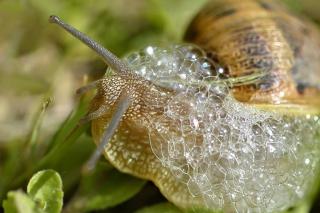 As the foot contracts from front to back, it releases mucus to coat the ground as it goes forward. How fast is a snail? About one millimeter per second.
As the foot contracts from front to back, it releases mucus to coat the ground as it goes forward. How fast is a snail? About one millimeter per second.
Frothy foam around a snail: this is the snail’s way of protecting itself from aggression.
Weird or wonderful, in any case a quirky gift of nature, snails are actually hermaphrodite. Each snail has both female and male genital organs, both of which intervene in the reproduction process. Two snails must meet in order to reproduce.
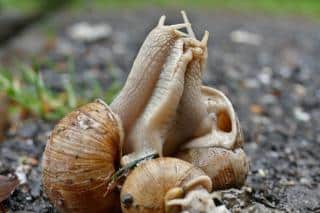 Since it’s deaf and nearly blind, a snail uses its front tentacles to find a partner. It follows the trail left by mucus as the snail moves along.
Since it’s deaf and nearly blind, a snail uses its front tentacles to find a partner. It follows the trail left by mucus as the snail moves along.Love dart: The mucus that coats the love dart is loaded with a special class of hormones. These hormones protect the sperm from simply being dissolved by the receiving snail, thus ensuring that genetic material carries on to the next generation.
This curious mating ritual can last up to ten hours. Both snails penetrate and fertilize each other.
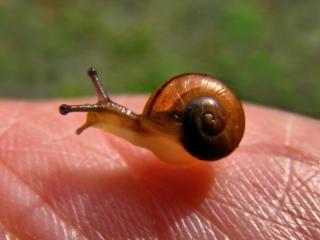 A few days later, mature eggs are ready for laying. They go their own ways, dig a hole in the ground, and lay between 20 and 100 eggs inside.
A few days later, mature eggs are ready for laying. They go their own ways, dig a hole in the ground, and lay between 20 and 100 eggs inside.Finding snails in your garden is actually a good sign. It proves you have good-quality soil, since snails are very picky and flee even the smallest traces of pollution. It must however be said: snails are a real burden when it comes to protecting hard-grown salads and cabbage.
Nonetheless, certain species of snails are truly useful in the garden. Some of them, like the Ruminia species, eat eggs and larvae of other snails and slugs, and digest insect or worm cadavers to release their nutrients in the soil. Others are scavenger snails, breaking down dead organic matter, moss, and fungus and mushrooms (even the poisonous ones). Thus, snails are truly part of a balanced garden.
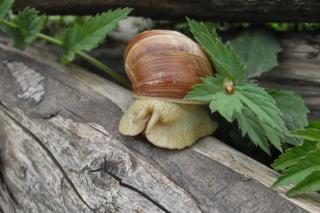 Lay down a slab of wood or a clay tile wherever snails tend to gather. During the day, they’ll hide underneath it. All you’ll need to do is pick them up and move them to a better place, or even feed them to their natural predators.
Lay down a slab of wood or a clay tile wherever snails tend to gather. During the day, they’ll hide underneath it. All you’ll need to do is pick them up and move them to a better place, or even feed them to their natural predators.
“Life is what our inner self wants it to be. We shape and form it like a snail builds its shell.”
Jules Renard, a French author of old.
L. D.